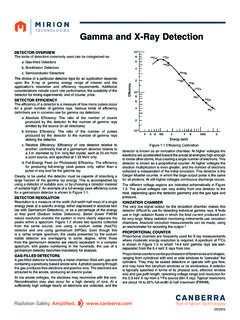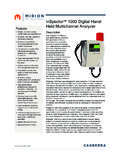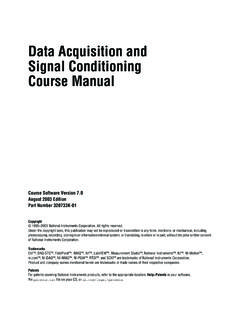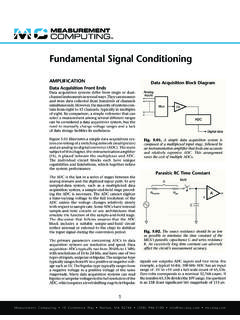Transcription of Lynx Digital Signal Analyzer Application Note
1 Application Note Lynx Digital Signal Analyzer Introduction The role of nuclear pulse processing hardware is to deliver the optimum resolution and throughput for a given detector system in a manner the user can readily analyze and interpret. Several factors dictate the appropriate data acquisition and analysis hardware needed for the best performance. Count rates spanning several orders of magnitude, transient count rates, different detector and preamplifier modalities, the range of gamma-ray energies of interest, dynamic environmental conditions such as temperature: these are all factors that must be taken into account when choosing an appropriate Digital spectrum Analyzer (DSA) for a gamma spectroscopy system. Digital Signal processors (DSP) have recently been favored over analog electronics for spectroscopy systems due to their superior environmental, count rate stability, and processing flexibility.
2 System Description Optimum performance over a wide range of activity and The Lynx DSA is a Digital Signal Analyzer designed to count rates is vital for any spectroscopic system across all accommodate any nuclear measurement situation. In a applications of nuclear measurements: nuclear safeguards, standalone, compact package (Figure 1), the Lynx is a highly the nuclear fuel cycle, power plant monitoring, border security integrated data acquisition instrument that incorporates and first response, assaying of nuclear waste, environmental front end Signal conditioning, a fast digitizing analog-to- and health monitoring, and scientific research. Detector Digital converter, programmable Digital shaping filters, Digital technologies such as HPGe, Si(Li), Si drift detectors, oscilloscope, automated pole-zero and base line restoration, CdTe, inorganic scintillators (NaI(Tl) and La-Halides), and advanced noise estimation algorithms.
3 The Lynx can organic scintillators, and CdZnTe are all utilized for these also be used in pulse height analysis, dual loss free counting, applications depending on the situation's specifications or multichannel scaling, multispectral scaling, and time-stamped functional requirements. Gamma and x-ray energies in many list modes. The Lynx can be operated with CANBERRA's applications can range from 1 keV into the tens of MeV. Genie 2000, Abacos, and Apex spectroscopy software Incoming count rates can span orders of magnitude in a packages, as well as independently with a Java-enabled web given spectroscopic situation. The Lynx is a state-of-the-art browser. The Lynx can also be controlled via a customer- DSP-based DSA designed to deliver the best performance created software Application through the utilization of its for any nuclear spectroscopy Application .
4 This note reports programming libraries. on its performance compared to earlier MCA technology and highlights many of its enhancements and capabilities. In this Application note, the first section describes the physical and functional features of the Lynx DSA. The next section compares the resolution performance in low count rate situations to CANBERRA's previous Digital DSA, the DSA-1000, as well as a NIM-based analog setup. The third section compares the resolution, energy stability, and throughput for these systems in high count rate environments. The following section highlights the benefits of the Lynx's wide dynamic range. The next section demonstrates the loss free counting capability of the Lynx and its benefits in high or transient count rate applications . The last section summarizes the evaluation of the Lynx DSA.
5 Figure 1. Lynx DSAs 1. Table 1 outlines the major enhancements over the DSA-1000, The multichannel scaling (MCS) mode has been enhanced CANBERRA's previous generation DSP-based bench-top to accommodate faster dwell times. The dual loss free DSA. The increase in the conversion gain of the DSA memory counting (DLFC) mode will be explained in a later section, to 32k channels has a couple of direct consequences. and the multispectral scaling (MSS) mode allows for rapidly First, by increasing the dynamic range, a wider gamma-ray collecting a large number of PHA spectra. In MSS mode, energy regime can be used effectively. Also, the throughput the two groups of spectral memory alternate in acquisition, performance is slightly enhanced. allowing for multiple spectral acquisitions with no dead time This is because the higher range can accommodate more between the acquisitions.
6 This is an extremely useful feature pile-up events in the DSA channels without saturating the when data acquisition needs to be synchronized with external spectral memory. Events that do overflow the range can motion of the sample being measured such as with radiation create a longer associated dead time for an MCA. The Lynx portal monitoring, segmented gamma scanning (SGS), and DSA primarily uses the trapezoidal filter to shape pulses from tomographic gamma scanning (TGS) applications . List mode the detector preamplifiers, but can be configured in the future acquisition is useful for many timing applications . Tagging with other shaping filters. The Lynx has more granularity for each event with a time stamp, list mode acquisition allows the filter shaping time settings than the DSA-1000 improving for analysis in the temporal domain.
7 applications depending the ability to fine tune and optimize measurement. on coincidence from multiple detectors, such as neutron coincidence counting for assaying fissile material or positron In addition, an automatic pole-zero algorithm has been emission tomography (PET), can be performed using this implemented in the Lynx. The Lynx adds capability for mode of acquisition. multispectral scaling, dual loss free counting, and list modes. Table 1. Features of two CANBERRA standalone Multichannel Analyzers based upon Digital Signal processing: the DSA-1000 and Lynx. Feature DSA-1000 Lynx Benefits Conversion Gain/Memory 16,000 channels Two groups of Extended Dynamic Range, Improved Throughput 32,000 channels Filter Type Trapezoidal Trapezoidal/Future Improved Fine Tuning Ability Capability for Others Filter Range Rise Time to 38 s in 40 steps to 51 s in 255 steps Improved Fine Tuning Ability Flat Top 0 to 3 s in 21 steps 0 to s in 33 steps Improved Fine Tuning Ability Pile-Up Rejection Threshold 1% steps steps Improved Fine Tuning Ability Coincidence Gate 4 External qualification of events Auto Pole Zero Assisted Pole Zero 4 Ease of Setup Multichannel Scaling Mode 5 ms to 10 sec in 2 s to 999 sec in Faster dwell times.
8 Wider Range 14 steps 1 s steps Multispectral Scaling Mode 4 Less Deadtime between measurements Dual Loss Free Counting 4 Decreased acquisition time for High Count Rates, Better measurement of Transient Count Rates Pulse Shape Discrimination Plans for Support for specialty detector types Future Capability List Mode Acquisition 4 Able to store simultaneous event time and amplitude USB Connectivity 4 4. Ethernet Connectivity 4 Improved connectivity Web-browser Controllable 4 Improved connectivity External Positive and 4 Ease of Setup Negative HV Connections Digital Oscilloscope Energy Shaper only Energy Shaper, Fast Shaper, Ease of Setup and Improved Diagnostics Thresholds ADC. (numerous Digital signals). Genie 2000 Supported 4 4. 2. Experimental Setup The Digital oscilloscope functionality has been enhanced Several tests were conducted to evaluate the performance over that of the DSA-1000.
9 The addition of a coincidence of the Lynx to its predecessor, the DSA-1000, as well as gate allows the Lynx to externally qualify the acceptance of to conventional analog electronics. The analog acquisition events. For instance, rejecting events from a cosmic-ray veto systems used were the following CANBERRA's NIM. detector or an active, anti-Compton detector can be easily modules: 2025 spectroscopic amplifier, 8076 ADC, 556A. incorporated. The Lynx oscilloscope allows a significant AIM multichannel Analyzer , and 2071 Scaler. A wide range number of additional signals to be monitored for setup and of detector types, preamplifiers, static and dynamic counting diagnostic purposes. The performance (update rate) of the rates, and gamma-ray nuclides were examined. For each scope is also greatly improved over the DSA-1000.
10 Several test, the relevant parameters are described in further detail. useful hardware features exist on the Lynx such as Ethernet connectivity, web-browser control, security and diagnostic functions. Low Count Rate Situation The first test demonstrates the low count rate performance of the Lynx compared to DSA-1000. Table 2 shows the list of various detectors tested and the MCA shaping times used. The incoming count rates were all approximately 2000-5000 counts per second (cps) during this test. Table 2. Detectors for low count rate test. Analog and Digital Shaping parameters are listed. Analog Shaping Rise Time Flat Top Shaping Detector Type Preamplifier ( s) Shaping ( s) Time ( s). Si CANBERRA X-PIPS Reset 12 Small Planar P-Type RC 4 Small Planar P-Type Optical Reset 12 Coaxial 40% P-Type HPGe RC 4 Coaxial 14% N-Type Reset N/A Large Planar 26% P-Type HPGe RC 6 NaI 3x3 inch RC 1 1 1.













